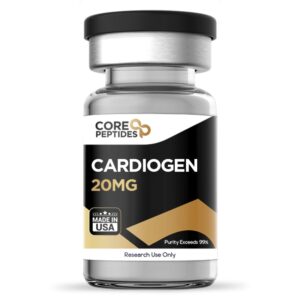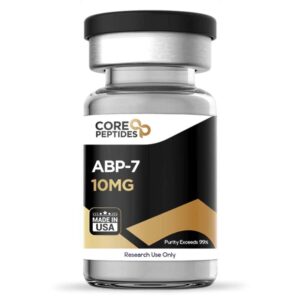Description
Epithalon Peptide
Epithalon, also known as AEDG peptide, Epitalon, or Epithalone, is a synthetic tetrapeptide composed of the amino acids Ala-Glu-Asp-Gly (AEDG). This peptide is derived from Epithalamin, a naturally occurring pineal peptide, and has been investigated for its potential geroprotective, antioxidant, and anti-aging properties. Research suggests that Epithalon may regulate pineal gland function, retinal health, and circadian rhythm, while also modulating cellular aging and telomerase activity.
Chemical Properties
-
Molecular Formula: C₁₄H₂₂N₄O₉
-
Molecular Weight: 390.34 g/mol
-
Peptide Type: Synthetic tetrapeptide
-
Other Names: AEDG peptide, Epitalon, Epithalone
Mechanism of Action
Epithalon’s biological activity is hypothesized to involve multiple mechanisms:
-
Epigenetic Regulation:
-
Binds to histones HI/3 and HI/6, altering chromatin structure.
-
Modulates gene expression, enhancing transcription of genes involved in neuronal differentiation and cell regeneration.
-
Upregulates markers like Nestin, GAP43, β Tubulin III, and Doublecortin, suggesting enhanced stem cell differentiation.
-
-
Telomere Extension:
-
Stimulates telomerase activity, potentially elongating telomeres and allowing additional cell divisions beyond the typical Hayflick limit.
-
Supports cellular longevity in fetal and adult fibroblasts.
-
-
Antioxidant Effects:
-
Reduces reactive oxygen species (ROS) levels in aged cells, including oocytes.
-
Preserves spindle integrity, cortical granule distribution, and mitochondrial function, supporting genomic stability and cellular survival.
-
-
Anti-Aging and Cellular Regeneration:
-
Enhances cell proliferation and regeneration markers such as Ki-67 and CD98hc.
-
Inhibits Caspase-3, reducing apoptosis in aging cells.
-
Modulates matrix remodeling, potentially improving tissue function over time.
-
-
Geroprotective Effects in Animals and Humans:
-
Increases melatonin levels in aging models, improving sleep regulation.
-
Preserves retinal function and structure, supporting vision in geriatric subjects.
-
Restores immune, cardiovascular, endocrine, and nervous system function in elderly humans.
-
Associated with reduced morbidity and mortality in long-term studies.
-
-
Anti-Mutagenic and Anti-Cancer Potential:
-
Reduces chromosomal aberrations in aged animal models.
-
Inhibits tumor metastasis and slows tumor growth in murine reproductive organ models.
-
-
Organ-Specific Effects:
-
Thymus gland restoration in hypophysectomized birds.
-
Modulation of lymphocytic chromatin, activating ribosomal genes in aged subjects.
-
Key Applications
-
Research on aging, longevity, and geroprotective therapies
-
Studies of telomerase activation and cellular regeneration
-
Investigation of oxidative stress, apoptosis, and genomic stability
-
Neurodegenerative and ocular research related to retinal health
-
Anti-cancer and anti-mutagenic studies
Important Notice
Epithalon peptide is for research and laboratory purposes only.
It is not approved for human consumption or medical use. Researchers should follow proper safety and handling protocols when using this peptide.
References
-
Khavinson VKh. Peptides and Ageing. Neuro Endocrinol Lett. 2002;23 Suppl 3:11–144. PMID: 12374906.
-
Khavinson, V. et al. AEDG Peptide (Epithalon) Stimulates Gene Expression and Protein Synthesis during Neurogenesis: Possible Epigenetic Mechanism. Molecules. 2020;25(3):609.
-
Anisimov VN, Mylnikov SV, Khavinson VK. Pineal peptide preparation epithalamin increases lifespan of fruit flies, mice, and rats. Mech Ageing Dev. 1998;103(2):123–132.
-
Yue X, et al. Epithalon protects against post-ovulatory aging-related damage of mouse oocytes in vitro. Aging (Albany NY). 2022;14(7):3191–3202.
-
Lin’kova NS, et al. Peptide Regulation of Skin Fibroblast Functions during Their Aging In Vitro. Bull Exp Biol Med. 2016;161:175–178.





Reviews
There are no reviews yet.